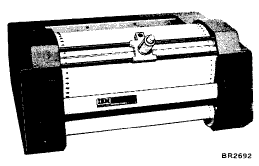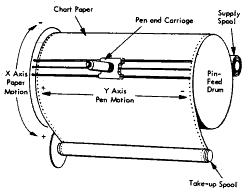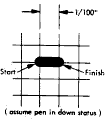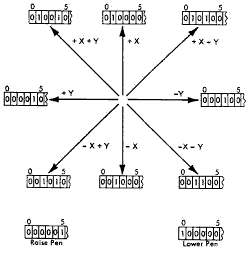
Figure 56. IBM 1627 Plotter
The IBM 1627 Plotter (Figure 56) provides an exceptionally versatile, reliable, and easy-to operate plotting system for the 1130 system. The plotter converts tabulated digital information into graphic form. Bar charts, flow charts, organization charts, engineering drawings, and maps are among the many graphic forms of data that can be plotted on the 1627.
Two models of the 1627 are available and the major characteristics are as follows:
See Figure 57 for more information. The 1627 is equipped with a ball point pen, which lasts for about five or six hours of continuous plotting. A liquid-flow ink pen is optional.

Figure 56. IBM 1627 Plotter
| Speed | X, Y Increments Pen Status Change |
Model 1 18,000 Steps/Min 600 Operations/Min |
Model 2 12,000 Steps/Min 600 Operations/Min |
| Increment Size |
1/100 Inch | 1/100 Inch | |
| Chart Paper |
Width Plotting Width Length Sprocket Hole Dimensions |
12 Inches 11 Inches 120 Feet .130 Inch Dia on 3/8 Inch Centers |
31 Inches 29 1/2 Inches 120 Feet .188 Inch Dia on 1 Inch Centers |
Figure 57. IBM 1627 Operating Characteristics
Data from core storage is transferred serially to the 1627 under direct program control, where it is translated into 1627 actuating signals. These signals are then converted into drawing movements by the 1627.
The actual recording is produced by incremental movement of the pen on the paper surface (y-axis) and/or the movement of the paper under the pen (x-axis). The pen is mounted in a carriage that travels horizontally across the paper. The vertical plotting motion is achieved by rotation of the pin feed drum, which also acts as a platen (Figure 58)

Figure 58. Plotter Paper and Pen Movement
The drum and the pen carriage are bidirectional; that is, the paper moves up or down, and the pen moves left or right. Control is also provided to raise or lower the pen from or to the paper surface. The pen remains in the raised or lowered position until directed to change to the opposite status.
The drum and the pen-carriage movements and the pen status are controlled by bits transferred to the 1627. Each output word is decoded into a directional signal that causes a 1/100 inch incremental movement of the pen carriage (Figure 59) and / or paper, or a raise-pen or lower-pen movement. The motion or action resulting from each word in the output record is shown in Figure 60.
The time required for execution of raise-pen and lower pen commands is 100 ms. The time to plot a point is approximately 3.3 ms model 1, or 5 ms model 2.
The 1627 Plotter operates under direct program control of the 1130 and responds on interrupt level 3.
The 1627 is addressed by the five-bit device code 00101.
Write (001)
![]()
This command causes bit positions 0 through 5 of the word in the core storage location specified by the address to be sent to the 1627 to control the movement of the pen or drum. (See Figure 60)
Sense Device (111)
![]()
This command causes the 1627 device status word (Figure 61) to be placed into the accumulator. Modifier bit 15 on specifies reset for the plotter response.
Plotter Response (Interrupt): This is the only interrupt associated with the 1627. This interrupt occurs when the 1627 has completed the action specified by the last write command. The 1627 is on interrupt level 3.
Not Ready: This indicates the 1627 is not ready to execute commands. A write command issued to the plotter when the not ready condition exists causes a plotter-response interrupt even though the plotter has not executed the command.
Busy: This indicates that the 1627 is in a busy status and cannot accept a character. After the first write command, the program should wait for succeeding plotter interrupts to issue additional write commands. If a write command is given while busy is on, loss of information will probably occur. No indication is given of this loss.

Figure 59. Result of One Horizontal (y-axis) Movement

Figure 60. Plotter Command Codes
Figure 61. 1627 Device Status Word
But wait, there's MORE...